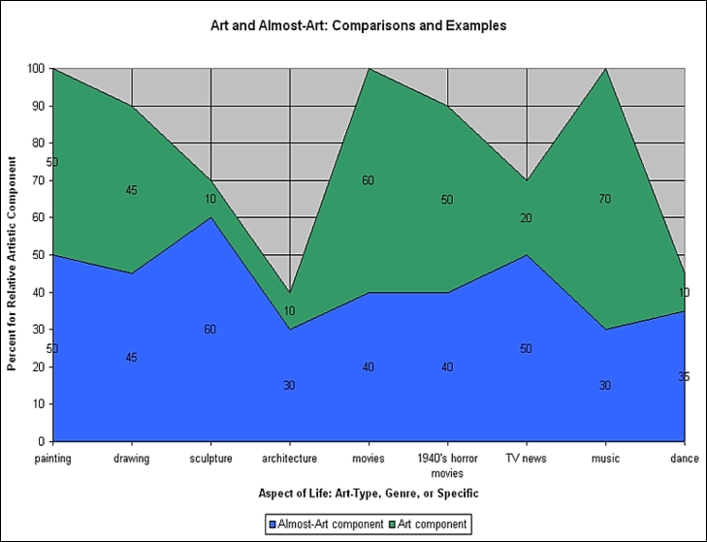We can compare various objects around us, or aspects of our lives, and rate them as to how much we consider them to be art or almost-art. There is non-art in every aspect of life, and there is enough almost-art to go around to make this web site worthwhile.
First, the chart; then, the explanation:

A more comprehensive version of the chart can be seen on this full-width page:
In the above chart (on the x-axis) there are a few things listed that we might think of as art (painting or music, for example).
The numbers in the chart are all percentages. The values of these numbers are debatable, and they could have been variables instead of numbers (since there are no particulars just categories), and so I just entered specific values to show differences. There would probably be general agreement at least that there should be differences between the numbers on this chart.
First, notice that the values for both almost-art and art for "plants in the wild" are both zero (on the detailed chart). By definition, where man (or woman, or space alien, or rhesus monkey) has not added value, the thing is non-art. So where we are seeing non-zero values for the other things listed on the chart, these values refer to a value-add that either falls into our generous attribution of "art" or the not-so-generous attribution of "almost-art."
Notice too, that I have arbitrarily given painting, music, and movies the possibility of being 100% artistic, while (and this, again, is open for debate) we might not have such a high regard for furniture design, or hair styles (yet, we still may see something artistic in those things too). This is to say, any particular painting has the opportunity of being as artistic as we can possibly imagine (hence 100%). This chart also suggests that because they lack the expression of color, drawings might not be capable of being maximally artistic—hence the arbitrary "90% artistic" rating. I arbitrarily gave sculpture a number of 70%, because the artist is limited in more ways by the additional laws of physics that come into play (again, this would be arguable).
The ratio of art to almost-art within an art-object might also be of interest. For example, while the whole painting is art, it is comprised of parts that are so small that they are in-and-of-themselves non-art (like little bits of paint). While the painting communicates an interesting thought to us, it also communicates a mundane thought to us. While the statue expresses beauty, it is also the biggest obstacle between us and lunch. The above chart describes the ratio for sculpture to be 60% almost-art, and only 10% of it to be really artistic. (Again, a sculptor may disagree with me, especially when applying the consideration to a particular art-object.)
The list is obviously not complete. Missing are: literature, cuisine, fireworks displays, computer games, dog breeding shows, and I'm sure you can think of several other areas in which there is obvious artistry.
Viewing art in this way, also, we can "drill down" a level, and, for example, distinguish between the amazing acting art of Jim Carey in a movie, and the non-acting non-art of an "extra" that just happens to be in the scene behind him. The furniture in the film would not, then, be considered as a separate art-object, but as non-art (the "when," see the Aspects page). Perhaps the arrangement of the furniture in the room could be considered mostly almost-art, and the cinematography of the film as "art" could be considered separately from the plot of the film as "art" (as they consider these things separately at Oscar time).
So again, as typified by the movie example, there are traces of art, traces of almost-art, and traces of non-art that can be disassociated from the art-object, while still being about it, and they can even permanently be disassociated from it (as in: displaying a jacket used by a famous actor in a movie in a Planet Hollywood restaurant, or considering the meme of the way someone walks), but these traces and parts together are and become the work as a whole when that is our consideration.

